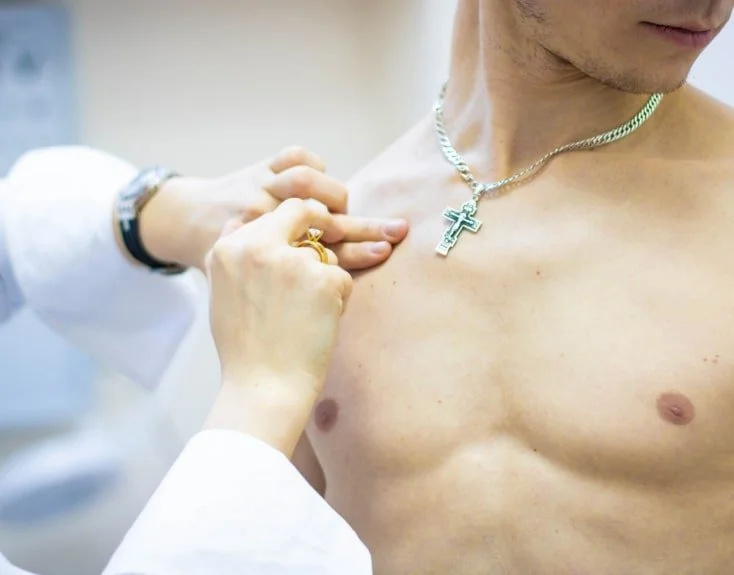Regain your masculine appearance with Male Breast Reduction Procedure
Remove Excess Male Breast Tissue
What is Gynecomastia Surgery?
Gynecomastia surgery is a cosmetic procedure to remove flabby, excess tissue from male chests. The outcome is a firm, flattened, and manly-looking chest. It is a procedure where incisions are made to cut out the fatty lumps or glandular tissues.
Male breast reduction surgery helps correct disproportional or heavy-looking chests. It helps chested males feel more comfortable with their looks. While it helps boost their self-esteem, it also makes men feel comfortable in their surroundings. The surgery can also help remove skin irritation and tenderness if breast tissue is excess.
Male breast reduction may be what you need to achieve the sculpted, more masculine chest you desire. It can also restore your overall body proportions, helping you gain confidence and achieve lasting results.
Ideal Candidate for Male Breast Reduction
Men with heavier breasts are an ideal candidate for male breast reduction surgery. Heavy breasts usually result from factors like hormonal imbalances, weight fluctuations, genetics, or side effects of certain medications. Men can develop gynecomastia at any age, causing the person to experience discomfort and be self-conscious.
Surgery is usually chosen when eating healthy or exercising hasn't helped reduce excess fat. Gynecomastia surgery performed on a generally fit person with a healthy weight who is a non-smoker delivers a smooth, natural result if he has firm, elastic skin.
It is possible for some men who experienced changes in their hormones during puberty to develop too much breast tissue that hasn't gone away. Also, men who have experienced weight gain or have used medications that make breast tissue swell (for instance, anabolic steroids or certain antidepressants) may benefit from gynecomastia surgery.
Your medical history and overall health status are considerable determinants in being a suitable candidate for male breast surgery.
Male Breast Reduction Procedure at The Centre for
Personal Surgery
The Centre for Personal Surgery practices male breast reduction procedures that are safe and customized to suit the unique needs of every patient. The procedure includes:
-

Consultation
Your surgeon will review your medical reports and run chest examinations to provide a suitable surgery option. Your expectations and goals will also be considered to customize the treatment plan. After the surgeon develops a plan, you will be explained about the procedure.
-

Surgery
General anesthesia is given to ensure the patient experiences less pain. Several incisions are made around the areola or in inconspicuous areas of the chest. Excess glandular tissue, fat, and sometimes skin are cut through the incisions during this process. Liposuction may be used to contour to have a more natural and masculine chest.
-

Recovery
Patients are generally discharged on the same day after gynecomastia surgery. After the procedure, the patient is kept in a recovery room. The caregivers observe the patient for the initial few hours, determining whether they feel discomfort or pain. Compression garments are provided to help better healing. The surgeon offers a list of medications and instructions for a smooth recovery.
Why Choose The Centre for Personal Surgery for Male Breast Reduction?
The Centre for Personal Surgery commits to providing exceptional care and lasting results in cosmetic surgery. Here’s what makes us stand out as experts in male breast reduction surgery.
-
Board-Certified Surgeon Expertise
The Centre for Personal Surgery staff is a talented mix of professionals. Dr. Weiglein is board-certified and has decades of expertise in performing minor and major cosmetic surgeries. They customize patients' procedures based on their personal goals and medical history.
-
State-of-the-Art Facilities and Cutting-edge Techniques
The latest technology and surgical techniques are essential to obtaining the best results. Our state-of-the-art facilities and advanced tools safely and effectively provide male chest contouring.
-
Positive Patient Testimonials and Success Stories
Male breast reduction surgery performed at our facility has helped many men regain their confidence. The positive feedback received from our patients, expressing their before- and after-surgery experiences, adds value to our success stories and strengthens our commitment to changing many lives.
-
Personalized Care Before, During, and After Surgery
The Centre for Personal Surgery strives to provide comfort and safety at every stage of your journey. From day 1 of consultation to planning the treatment plan, surgery, and after-care, our team of experts guides you through the process.
Recovery and Aftercare for
Male Breast Reduction
The recovery process after a gynecomastia surgery usually spans a few weeks to months. The recovery duration primarily depends on how strictly the patient follows the surgeon’s aftercare instructions. Here is a breakdown of the recovery process:
-

Initial Days
You’ll have some swelling, bruising, and chest discomfort immediately after surgery. As normal, these symptoms can be managed with prescribed pain medication. To reduce swelling and help support healing tissues, you must wear a compression garment around the chest.
-

First Week
The first week is to rest and avoid a lot of activity, like heavy lifting. Light walking is encouraged to help circulation and prevent blood clots. Within 1 to 2 weeks, most patients can return to light work but should avoid more strenuous activity, including exercise, for several weeks to months.
-

Follow-Up Appointments
After your stitches are removed, you will receive dates for follow-up appointments. This helps to track your progress. To ensure your recovery and surgery are successful, you must visit your surgeon as per the appointment dates.
-

Long-Term Care
Initial recovery takes a few weeks but is completed over time, and final male chest contouring results may take several months to show. During this time, your scars will continue to fade, and the chest will finally work itself into its new shape.
You get long-lasting natural results when you follow your surgeon’s male breast reduction aftercare guidelines.
Male Breast Reduction Surgery: What to Expect
Consultation, Surgery, and Recovery are the three essential phases of gynecomastia surgery.
During phase one, your surgeon learns about your expectations, evaluates your past medical reports, develops a treatment plan, and discusses it with you. In the second phase, you will be prepared to undergo the surgery, a general anesthesia will be given to minimize the pain. The third phase involves after-surgery care. You will be provided strict instructions by the surgeon that will aid in faster healing.
It is also important to visit the doctor for follow-up appointments. These meetings help track your progress and ensure successful and long-lasting surgery results.
Get Renewed Confidence with Male Breast Reduction
Achieve a flatter, more masculine chest with the help of Dr. Weiglein at The Centre for Personal Surgery. Take the first step to feel your best self. Schedule a personalized consultation today!
FAQs
-
Male breast reduction surgery has no strict age limits, but candidates must be fully developed and meet certain health requirements. Gynecomastia surgery can be performed on men of all ages (teenagers, young men, and middle-aged men) who meet the criteria for surgery.
-
The technique depends on the amount of gynecomastia and the patient’s anatomy. The surgery aims to reduce breast tissue, fat, and skin and create a more manly chest. The most common techniques include liposuction, excision or a combination of both.
-
The length of male breast reduction surgery depends on how complicated the operation is and which techniques you use. The surgery usually lasts 1 to 3 hours. After the anesthesia is injected, the doctor makes the incisions, removes excess tissues and closes the incisions. Patients can go home on the same day after the effects of anesthesia wanes off.
-
Male breast reduction surgery involves some risks, although these complications are relatively rare if a board-certified surgeon does the surgery. The most common risks associated with gynecomastia surgery are scarring, infection, asymmetry, hematoma or seroma, changes in sensation and anesthesia complications.
-
Results from male breast reduction surgery are long-lasting, sometimes permanent. Significant weight loss or gain, medications, or hormonal changes can affect the results. You can expect to keep your results long-term by maintaining a healthy lifestyle and treating underlying conditions.
-
For some, paying the entire fee for male breast reduction surgery can be a problem. At The Centre for Personal Surgery, we offer flexible financing options. We have flexible payment plans and partnerships with medical financing and health insurance companies. These help patients pay the fees at their convenience over a certain period.
-
If you want to lose even more weight after male breast reduction surgery, it can significantly affect the results of the surgery. Maintaining a stable weight is generally advisable to avoid skin loosening. If weight loss happens after the surgery, revision surgery or skin tightening surgery may be needed.
-
While any surgical procedure comes with some pain, this pain is manageable for most patients. Depending on the technique, type of surgery, and your pain tolerance capacity, the level of discomfort the patient experiences varies. While the person may feel mild to moderate pain from surgery through the recovery, it generally reduces after the first week.
-
Recovery times for male breast reduction surgery may vary widely depending on the patient, type of surgery, and the type of work or physical activities being performed. A week’s rest is generally advisable. After week one, the patient can resume light activities. Heavy exercises should be strictly avoided until six weeks.




